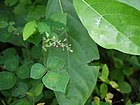Note: This is a project under development. The articles on this wiki are just being initiated and broadly incomplete. You can Help creating new pages.
Pseudarthria viscida
Pseudarthria viscida is an ascending, much branched perennial plant with stems that become more or less woody and persist; it can grow from 60 - 120cm tall often clothed with hooked hairs. The plant is very commonly used in Ayurvedic medicine, being harvested from the wild and traded. It has potential for use as a green manure.
Contents
- 1 Uses
- 2 Parts Used
- 3 Chemical Composition
- 4 Common names
- 5 Properties
- 6 Habit
- 7 Identification
- 8 List of Ayurvedic medicine in which the herb is used
- 9 Where to get the saplings
- 10 Mode of Propagation
- 11 How to plant/cultivate
- 12 Commonly seen growing in areas
- 13 Photo Gallery
- 14 References
- 15 External Links
Uses
Bronchial asthma, Cough, Bronchitis, Tuberculosis, Biliousness, Dyspepsis, Vomitting, Food poisoning, Diarrhoea, Nervous dysfunction, Diabetes mellitus.[1]
Parts Used
[[:Category:Herbs with used in medicine|]], stem, leaves, Root.
Chemical Composition
The root of the plant has been reported to contain leucopelargonidin, flavonoids and proteins.[2]
Common names
| Language | Common name |
|---|---|
| Kannada | ಅಂಟುಬೆಳೆ ಗಿಡ Antubele gida, ಅಂಟುಪರ್ಣಿ Antuparni, |
| Hindi | Chapakno |
| Malayalam | Moovila, Salaparni |
| Tamil | Muvilai-paccilai, Muvilai-p-punnai |
| Telugu | Muyak, Muyyakuponna |
| Marathi | Chikta |
| Gujarathi | |
| Punjabi | |
| Kashmiri | |
| Sanskrit | Prsniparni, Salaparni |
| English | Viscid pseudarthria |
Properties
Reference: Dravya - Substance, Rasa - Taste, Guna - Qualities, Veerya - Potency, Vipaka - Post-digesion effect, Karma - Pharmacological activity, Prabhava - Therepeutics.
Dravya
Rasa
Guna
Veerya
Vipaka
Karma
Prabhava
Habit
Identification
Leaf
| Kind | Shape | Feature |
|---|---|---|
Flower
| Type | Size | Color and composition | Stamen | More information |
|---|---|---|---|---|
| {{{5}}} |
Fruit
| Type | Size | Mass | Appearance | Seeds | More information |
|---|---|---|---|---|---|
Other features
List of Ayurvedic medicine in which the herb is used
Where to get the saplings
Mode of Propagation
How to plant/cultivate
This species has not yet been evaluated for the IUCN Red List, but its excessive collection from the wild has resulted in a gradual disappearance of the plant from its natural habitat, and at present its number is highly reduced in the wild.[5]
Commonly seen growing in areas
Grassy fields, Roadsides, Thickets.
Photo Gallery
References
- ↑ Indian Medicinal Plants by C.P.Khare
- ↑ Chemical constituents
- ↑ Common names
- ↑ [Morphology]
- ↑ Cultivation details
External Links
- Ayurvedic Herbs known to be helpful to treat Bronchial asthma
- Ayurvedic Herbs known to be helpful to treat Cough
- Ayurvedic Herbs known to be helpful to treat Bronchitis
- Ayurvedic Herbs known to be helpful to treat Tuberculosis
- Ayurvedic Herbs known to be helpful to treat Biliousness
- Ayurvedic Herbs known to be helpful to treat Dyspepsis
- Ayurvedic Herbs known to be helpful to treat Vomitting
- Ayurvedic Herbs known to be helpful to treat Food poisoning
- Ayurvedic Herbs known to be helpful to treat Diarrhoea
- Ayurvedic Herbs known to be helpful to treat Nervous dysfunction
- Ayurvedic Herbs known to be helpful to treat Diabetes mellitus
- Herbs with used in medicine
- Herbs with stem used in medicine
- Herbs with leaves used in medicine
- Herbs with Root used in medicine
- Herbs with common name in Kannada
- Herbs with common name in Hindi
- Herbs with common name in Malayalam
- Herbs with common name in Tamil
- Herbs with common name in Telugu
- Herbs with common name in Marathi
- Herbs with common name in Sanskrit
- Herbs with common name in English
- Habit - Shrub
- Index of Plants which can be propagated by Seeds
- Herbs that are commonly seen in the region of Grassy fields
- Herbs that are commonly seen in the region of Roadsides
- Herbs that are commonly seen in the region of Thickets
- Herbs




